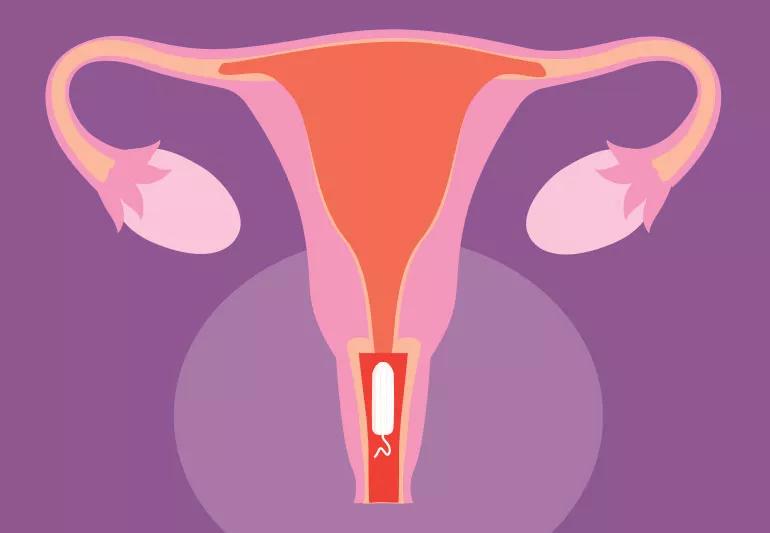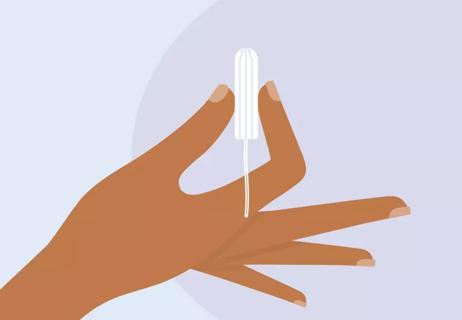It can get squished and lodged, but not lost

Tampons are popular because they’re easy to use and they allow you to keep living your regular life while you’re on your period. But every once in a while, a tampon gives you trouble.
Advertisement
Cleveland Clinic is a non-profit academic medical center. Advertising on our site helps support our mission. We do not endorse non-Cleveland Clinic products or services. Policy
Maybe you forgot you had one in, so you put in a second tampon without removing the first. Or maybe you had sex and didn’t even think to take out your tampon before you got busy. Either way, that little piece of cotton is now lodged somewhere up inside of you — and you’re probably freaking out.
Good news: This predicament is more common than you might think, and it’s pretty easily remedied. Certified nurse practitioner Sara Youngblood, CNP, explains how a tampon gets stuck, what to do to remove it and when to seek help from a healthcare provider.
First, some reassurance: There’s absolutely no way to lose a tampon in your body. It can get stuck in your vaginal canal, but it can’t go any farther than that.
That’s because your vagina is sort of like a dead-end road. You insert a tampon into your vaginal canal, which is only a few inches long, and that’s where the road ends. At the back end of your vaginal wall is your cervix, which acts as a barrier between your vagina and your uterus. And the cervix isn’t just a “Do not enter” sign that tampons can sneak past — it’s more like an impenetrable brick wall.
“The opening to the cervix isn’t even remotely big enough to let a tampon into the uterus,” Youngblood explains. “Based on the physiological components of the reproductive system, there is no physical way for a tampon to get past your vaginal canal and into the rest of your body.”
Advertisement
Although tampons can’t go farther than your vagina, they can get lodged in there. Your vaginal canal is only three or four inches long, but sometimes, a tampon can get stuck just out of your reach.
If you accidentally have sex with a tampon in, or if you put in a second tampon without removing the first, it can get pushed high up in your vaginal canal, where it can get squished or turned around. And when you lose track of the string, removal can get a little complicated.
“It may not be totally easy to find or to remove a tampon,” Youngblood says, “but there’s always a way to be able to get it out.”
A tampon that has taken up residence in your vagina is unlikely to come out by itself, so it’s important that you take steps to remove it.
“Leaving it in or not knowing that you have a retained tampon can lead to serious health concerns,” Youngblood warns. Wearing the same tampon for longer than eight hours can lead to:
First things first, take a deep breath and try not to panic. Though you may not be accustomed to poking around inside of your body, it’s the best way to remove a tampon that’s gotten lodged a bit too far north.
“Insert one or two fingers into your vagina and gently feel around to see if you can find the string or actual tampon itself to pull it out,” Youngblood instructs. Try using your ring finger, your middle finger or both of them at the same time so you can reach as deep into your vaginal canal as possible.
Here are some other tips for safely retrieving a retained tampon:
Advertisement
“If you aren’t able to get a stuck tampon out by yourself, it’s time to see a medical professional to help remove it,” Youngblood says.
Call your family doctor or Ob/Gyn’s office, and if they can’t fit you in, they might refer you to urgent care or express care, where you can be seen faster. Typically, a healthcare provider can easily remove a stuck tampon using their fingers or a small clamp. It may be uncomfortable, but it probably won’t hurt — kind of like an average pelvic exam.
And although your instinct might be to feel embarrassed about asking for help removing a stuck tampon, try to remember: You’re not the first person this has happened to, and you won’t be the last. Your medical providers have seen this before, and they’re there to help you, not to judge you. Your health is more important than your pride!
Advertisement
Learn more about our editorial process.
Advertisement

It depends on your menstrual flow, and a little trial and error

Yes, with the right absorbency level and maximum time-frame

There are better — and healthier — ways to be environmentally friendly

From using one at night to how often you should change them

They won’t make your cramps worse or stretch out your vagina!

In addition to toxic shock syndrome, you risk other vaginal infections

Key steps include picking the right level of absorbency and inserting it at the correct angle

The truth behind this “hygiene” illusion

Type 2 diabetes isn’t inevitable with these dietary changes

Applying a hot or cold compress can help with pain